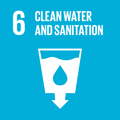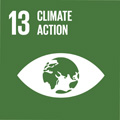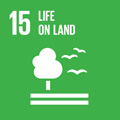- Docente: Donatella Pavanelli
- Credits: 6
- SSD: AGR/08
- Language: Italian
- Teaching Mode: Traditional lectures
- Campus: Bologna
-
Corso:
Second cycle degree programme (LM) in
Planning and management of agro-territorial, forest and landscape (cod. 8532)
Also valid for Second cycle degree programme (LM) in Sciences and Management of Nature (cod. 9257)
Second cycle degree programme (LM) in Sciences and Management of Nature (cod. 9257)
Learning outcomes
To provide tools for landscape survey and analysis, giving a startpoint for handling soil and water conservation issues, in an approach integrated with the environment and its hydrological, hydraulic and geomorphological aspects.
Course contents
Surface runoff erosion, slope instability, mass movement. Geotechnics characterisation rocks versus water.
Soil loss predictions , modelling soil erosion, Universal Soil Loss Equation.Action of watercourses . Surface water circulation. Hydrography and patterns of stream drainage area
Elements of fluvial hydrology Water flow, measurement methods. Coefficient of discharge.Modes of transport: suspension, traction and solution
Sediment yield from river basin. Basin water balance, drainage coefficient.Discharge hydrograph, characteristic curves
Study of precipitation and water flow extremes for the design of fluvial engineering works: climate possibility distributions, Gumbel statistical analysis, storm return time.
Subsurface water , water table and artesian aquifers, wells.
Biothecnical slope protection : water control and slope protection. Role of vegetation in the stability and protection of slopes.. Rules, hydrogeology principlesWind erosion protection : hydraulic-forestry engineering techniques.
Topic-specific cartography : Reading and interpretation of topic-specific maps (slope, lithologic and slope-distribution stability, etc.)
The practical exercises concern the following topics and others of the program: the reading of the basic and thematic topographic maps, the identification of a water catchment area, the hydrography, the isoipse and the reconstruction of profiles and slope calculations.
A group work is proposed: how to deal with the realization of a naturalistic engineering arrangement project referring to a real case. The project will be presented to colleagues as PP, together with the report applies to the final exam.
Readings/Bibliography
D. Pavanelli (2005). Appunti dalle lezioni: Tutela ambientale e riassetto idraulico del territorio. Bologna, pubbl. in proprio, p. 1-110
D. Pavanelli, Geologia applicata e idrologia. Appunti dalle lezioni per i corsi in teledidattica interfacoltà dell'Univ. Cattolica Sacro Cuore, Laurea in Sc. per l'ambiente e il territorio (sede Brescia)e Laurea in Sc. Agroambientali e del territorio (sede Piacenza). Pubbl. in proprio, Bologna, giugno 2005, pp. 1-181
- V. Bagarello, V. Ferro, Erosione e conservazione del suolo, McGraw-Hill , 2006
- G. Gisotti, F.Zarlenga, Geologia Ambientale, principi e metodi, D.Flaccovio ed. PA 2004
- F.Florineth, Piante al posto del cemento, manuale di Ingegnaria naturalistica e verde tecnico, ed. Il verde editoriale, MI, 2007.
- M. Greppi, Idrologia – Hoepli ed. 2004
- L.Da Deppo, C.Datei, P.Saladin, Sistemazione dei corsi d'acqua Ed. LibreriaCortina Padova, 1997
- N. Matarrese, Idraulica Agraria – ed. Laterza
- F.Basso, Difesa del suolo e tutela dell'ambiente - Pitagora Ed. Bologna, 1995
- Manuale tecnico di ingegneria naturalistica – Regione Emilia Romagna e Veneto
- D.H.Gray, A.T.Leiser, Biotechnical slope protection and erosion control – Krieger Publshing Company Malabar, Florida
- U.Maione, A.Brath, L'ingegneria naturalistica nella sistemazione dei corsi d'acqua – Ed. BIOS Cosenza
Teaching methods
The course is activated in online Teachings
https://iol.unibo.it/course/index.php?categoryid=566
https://iol.unibo.it
access with students' institutional credentials.
The teaching of Agro-forestry Hydraulics consists of educational visits in the field with the support of technical staff of public bodies and practical exercises, also.
There will be seminars in collaboration with Technicians (Region, Reclamation Consortia, etc.) and Researchers on specific topics.
The teaching of Soil erosion and bioengineering settlements consists of 4 cfu and is borrowed from agro-forestry hydraulics. The program excludes two topics that will be indicated by the teacher.
Assessment methods
Examination final oral exam
Teaching tools
The course is also in E-LEARNING, cartography, aerial images
Teaching is also active in e-learning on Moodle-platform UNIBO
https://iol.unibo.it/course/index.php?categoryid=566
https://iol.unibo.it
Links to further information
https://iol.unibo.it/course/index.php?categoryid=566
Office hours
See the website of Donatella Pavanelli
SDGs



This teaching activity contributes to the achievement of the Sustainable Development Goals of the UN 2030 Agenda.
